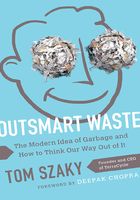
A Circular Solution to Waste
To properly manage our waste, we need to bring a perspective of value to it, as nature does. Instead of seeing waste purely as a negative—a useless by-product that we spend money to burn or bury—perhaps we can start seeing it as a positive: an inherently valuable combination of materials that can be processed and shaped into objects with specific purposes. The key is to see our outputs not as problems but as assets; it is to see “waste” not as the end of a linear process but as a stage in a circular life cycle.
Reuse—a synonym of buying used—is perhaps the solution that most clearly sees the value inherent in our waste. It effectively says that the “waste” object is waste only in the eyes of the initial user; the object retains all of its initial utility in the eyes of the next user and because of that perspective doesn’t actually end up as “garbage.” If I’m tired of my jeans and put them in the local clothing drop and someone else buys them a few months later, that pair of pants was never rendered waste: they didn’t end up in a landfill, and a new pair of pants did not have to be made to meet the needs or desires of the second user.
Not everything is as simple to reuse as a pair of jeans, and most human waste cannot be reused at all. From an empty potato chips bag to a used toothbrush, many objects can serve their intended function only once. Upcycling is an emerging trend whereby one sees value in both the composition and the form of an object but not the intention. That crumpled bag that once held a few handfuls of chips can be folded into a purse or bracelet. The used toothbrush can become a pen, a doormat, or one of any number of useful objects. Although more energy is used to upcycle an object than is needed to simply reuse it, it is usually a relatively small amount.
If upcycling a particular waste product is not possible—as is the case with items like dirty diapers and cigarette butts—the product can typically be deconstructed into its component parts and used again. A used diaper or pile of cigarette butts can be shredded and separated into their respective raw materials. The resulting material, from the plastic to the organics, can be used again for different purposes. While the initial intention and form of the object is destroyed, new raw materials don’t have to be extracted from the earth, and synthetic products aren’t added to a landfill or some plastic island in the ocean.